Corporate Financial Management: Planning, Strategy, and Performance
VerifiedAdded on 2023/03/20
|9
|2114
|94
Report
AI Summary
This report provides a comprehensive overview of corporate financial management (CFM), emphasizing its critical role in business strategy, planning, and decision-making. It explores how CFM, through the allocation of financial resources, aims to maximize shareholder value and increase company share prices. The report delves into key aspects of CFM, including financing decisions, investment strategies, and dividend policies. It also examines the significance of financial statements and the use of tools like SWOT analysis for effective decision-making and performance measurement. The report highlights the importance of financial information for various stakeholders, including management, owners, lenders, and investors. It also discusses the impact of internal and external events on a company's financial performance. Furthermore, the report outlines the key tools used in decision-making, such as SWOT analysis, and acknowledges the limitations of financial statements. Ultimately, the report underscores the significance of financial knowledge for managers and other stakeholders, emphasizing its role in strategic planning, performance control, and objective decision-making in a dynamic business environment.
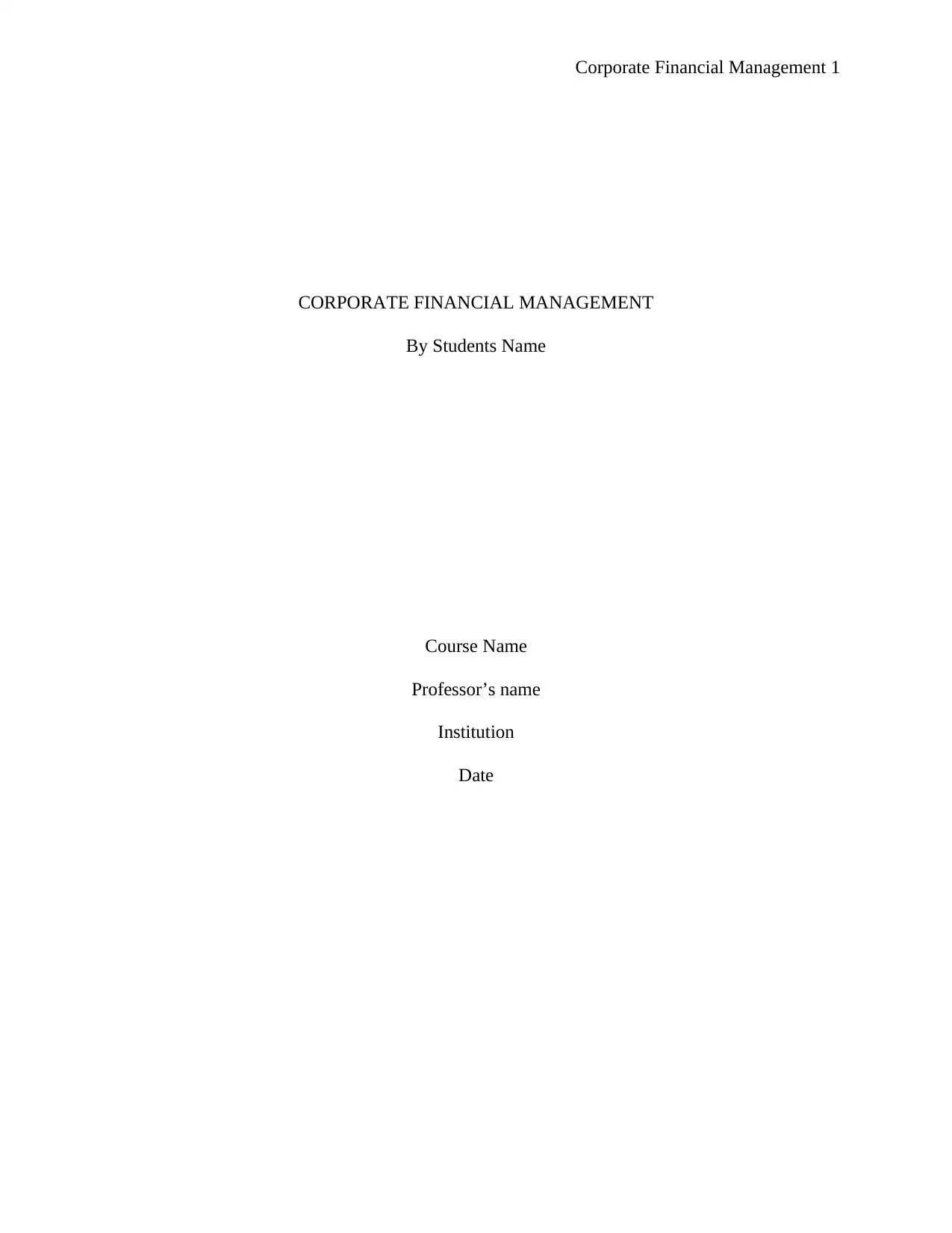
Corporate Financial Management 1
CORPORATE FINANCIAL MANAGEMENT
By Students Name
Course Name
Professor’s name
Institution
Date
CORPORATE FINANCIAL MANAGEMENT
By Students Name
Course Name
Professor’s name
Institution
Date
Paraphrase This Document
Need a fresh take? Get an instant paraphrase of this document with our AI Paraphraser
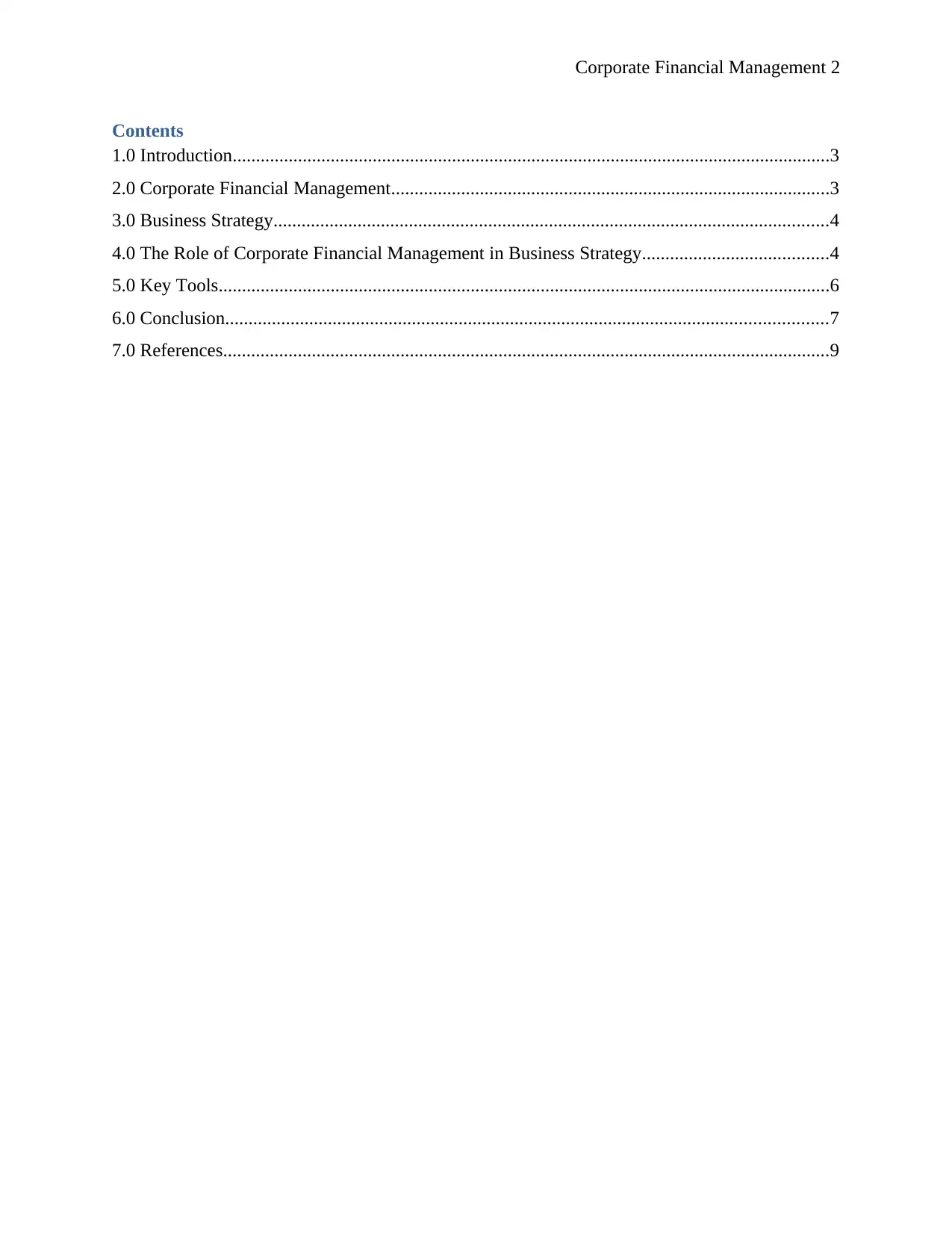
Corporate Financial Management 2
Contents
1.0 Introduction................................................................................................................................3
2.0 Corporate Financial Management..............................................................................................3
3.0 Business Strategy.......................................................................................................................4
4.0 The Role of Corporate Financial Management in Business Strategy........................................4
5.0 Key Tools...................................................................................................................................6
6.0 Conclusion.................................................................................................................................7
7.0 References..................................................................................................................................9
Contents
1.0 Introduction................................................................................................................................3
2.0 Corporate Financial Management..............................................................................................3
3.0 Business Strategy.......................................................................................................................4
4.0 The Role of Corporate Financial Management in Business Strategy........................................4
5.0 Key Tools...................................................................................................................................6
6.0 Conclusion.................................................................................................................................7
7.0 References..................................................................................................................................9
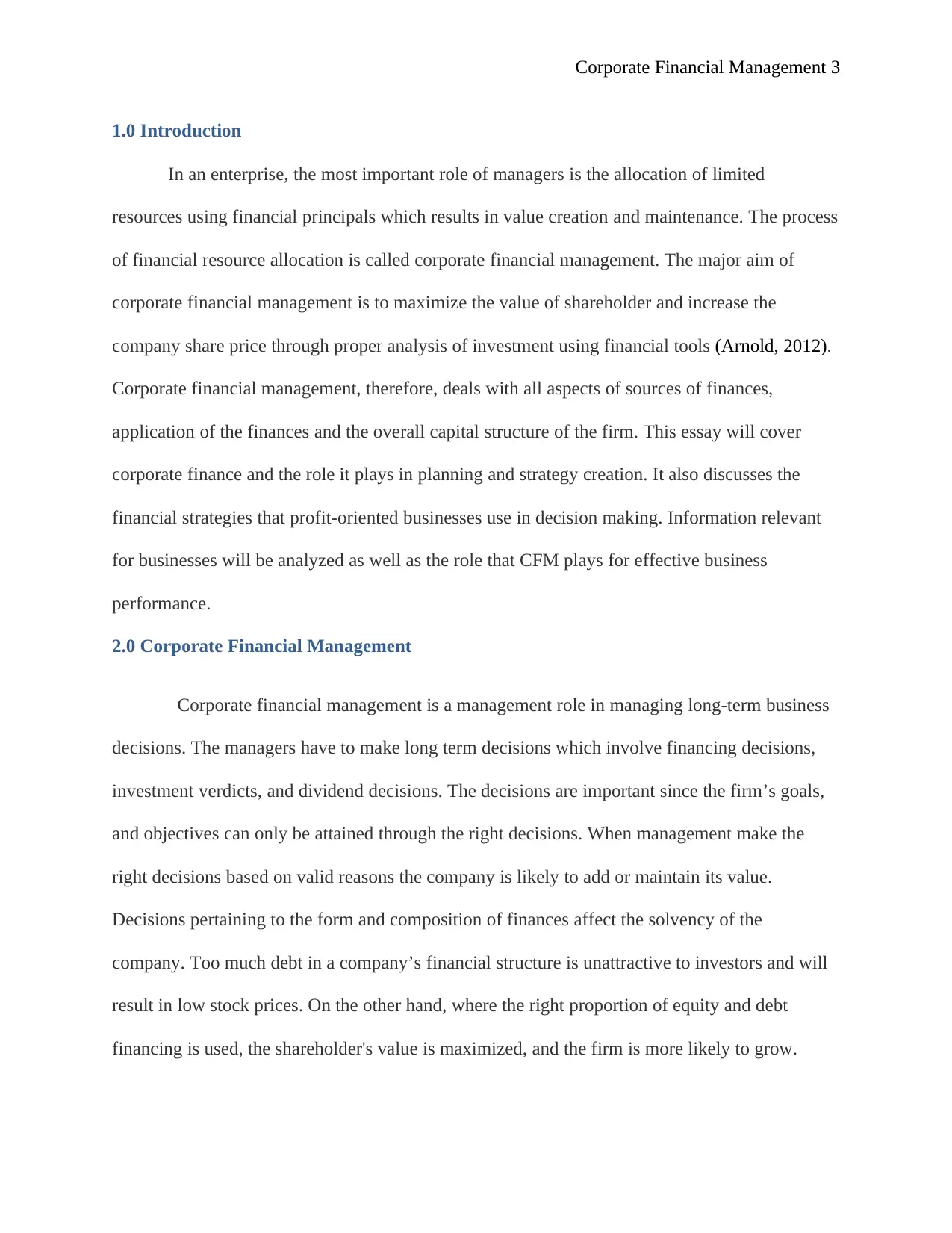
Corporate Financial Management 3
1.0 Introduction
In an enterprise, the most important role of managers is the allocation of limited
resources using financial principals which results in value creation and maintenance. The process
of financial resource allocation is called corporate financial management. The major aim of
corporate financial management is to maximize the value of shareholder and increase the
company share price through proper analysis of investment using financial tools (Arnold, 2012).
Corporate financial management, therefore, deals with all aspects of sources of finances,
application of the finances and the overall capital structure of the firm. This essay will cover
corporate finance and the role it plays in planning and strategy creation. It also discusses the
financial strategies that profit-oriented businesses use in decision making. Information relevant
for businesses will be analyzed as well as the role that CFM plays for effective business
performance.
2.0 Corporate Financial Management
Corporate financial management is a management role in managing long-term business
decisions. The managers have to make long term decisions which involve financing decisions,
investment verdicts, and dividend decisions. The decisions are important since the firm’s goals,
and objectives can only be attained through the right decisions. When management make the
right decisions based on valid reasons the company is likely to add or maintain its value.
Decisions pertaining to the form and composition of finances affect the solvency of the
company. Too much debt in a company’s financial structure is unattractive to investors and will
result in low stock prices. On the other hand, where the right proportion of equity and debt
financing is used, the shareholder's value is maximized, and the firm is more likely to grow.
1.0 Introduction
In an enterprise, the most important role of managers is the allocation of limited
resources using financial principals which results in value creation and maintenance. The process
of financial resource allocation is called corporate financial management. The major aim of
corporate financial management is to maximize the value of shareholder and increase the
company share price through proper analysis of investment using financial tools (Arnold, 2012).
Corporate financial management, therefore, deals with all aspects of sources of finances,
application of the finances and the overall capital structure of the firm. This essay will cover
corporate finance and the role it plays in planning and strategy creation. It also discusses the
financial strategies that profit-oriented businesses use in decision making. Information relevant
for businesses will be analyzed as well as the role that CFM plays for effective business
performance.
2.0 Corporate Financial Management
Corporate financial management is a management role in managing long-term business
decisions. The managers have to make long term decisions which involve financing decisions,
investment verdicts, and dividend decisions. The decisions are important since the firm’s goals,
and objectives can only be attained through the right decisions. When management make the
right decisions based on valid reasons the company is likely to add or maintain its value.
Decisions pertaining to the form and composition of finances affect the solvency of the
company. Too much debt in a company’s financial structure is unattractive to investors and will
result in low stock prices. On the other hand, where the right proportion of equity and debt
financing is used, the shareholder's value is maximized, and the firm is more likely to grow.
⊘ This is a preview!⊘
Do you want full access?
Subscribe today to unlock all pages.

Trusted by 1+ million students worldwide
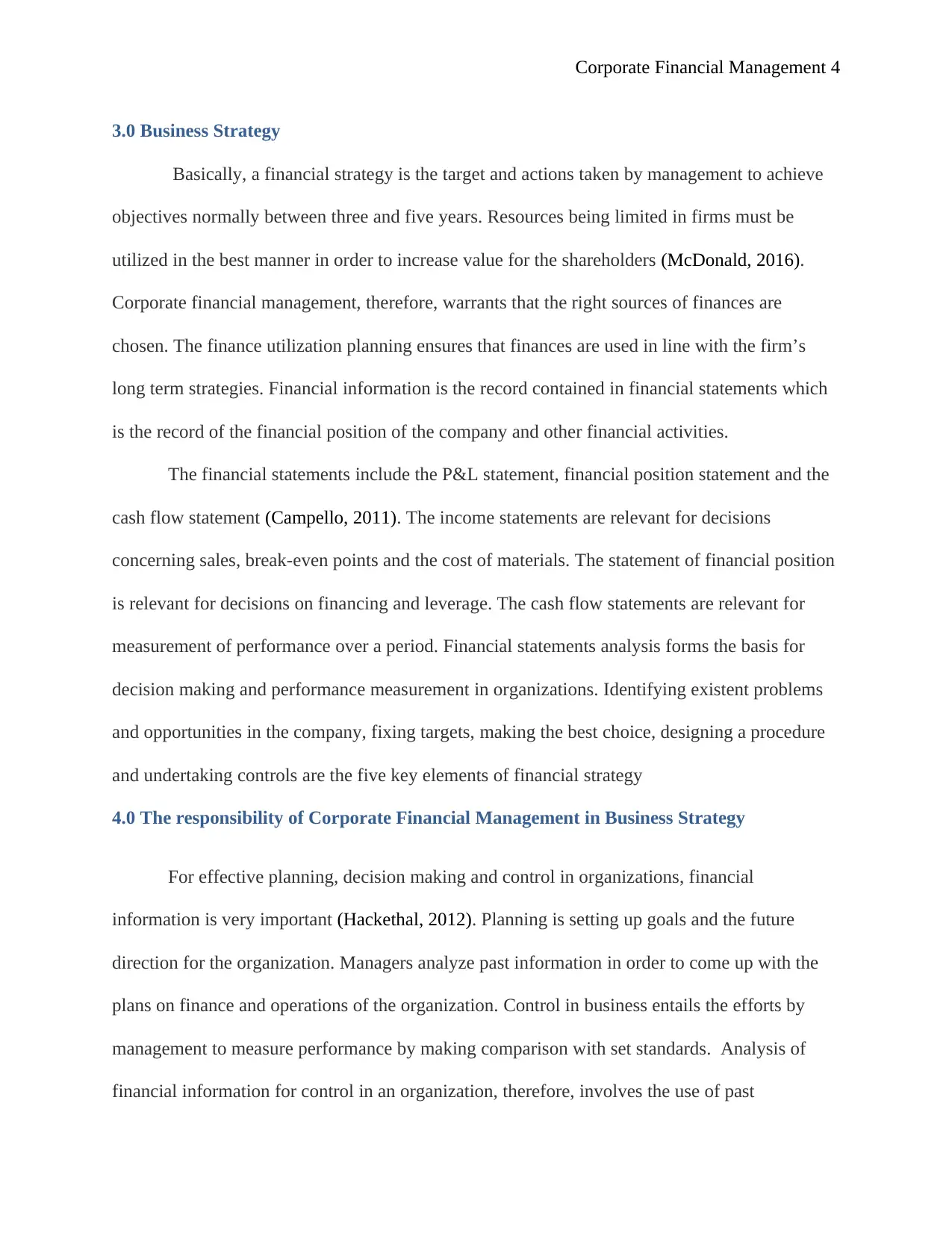
Corporate Financial Management 4
3.0 Business Strategy
Basically, a financial strategy is the target and actions taken by management to achieve
objectives normally between three and five years. Resources being limited in firms must be
utilized in the best manner in order to increase value for the shareholders (McDonald, 2016).
Corporate financial management, therefore, warrants that the right sources of finances are
chosen. The finance utilization planning ensures that finances are used in line with the firm’s
long term strategies. Financial information is the record contained in financial statements which
is the record of the financial position of the company and other financial activities.
The financial statements include the P&L statement, financial position statement and the
cash flow statement (Campello, 2011). The income statements are relevant for decisions
concerning sales, break-even points and the cost of materials. The statement of financial position
is relevant for decisions on financing and leverage. The cash flow statements are relevant for
measurement of performance over a period. Financial statements analysis forms the basis for
decision making and performance measurement in organizations. Identifying existent problems
and opportunities in the company, fixing targets, making the best choice, designing a procedure
and undertaking controls are the five key elements of financial strategy
4.0 The responsibility of Corporate Financial Management in Business Strategy
For effective planning, decision making and control in organizations, financial
information is very important (Hackethal, 2012). Planning is setting up goals and the future
direction for the organization. Managers analyze past information in order to come up with the
plans on finance and operations of the organization. Control in business entails the efforts by
management to measure performance by making comparison with set standards. Analysis of
financial information for control in an organization, therefore, involves the use of past
3.0 Business Strategy
Basically, a financial strategy is the target and actions taken by management to achieve
objectives normally between three and five years. Resources being limited in firms must be
utilized in the best manner in order to increase value for the shareholders (McDonald, 2016).
Corporate financial management, therefore, warrants that the right sources of finances are
chosen. The finance utilization planning ensures that finances are used in line with the firm’s
long term strategies. Financial information is the record contained in financial statements which
is the record of the financial position of the company and other financial activities.
The financial statements include the P&L statement, financial position statement and the
cash flow statement (Campello, 2011). The income statements are relevant for decisions
concerning sales, break-even points and the cost of materials. The statement of financial position
is relevant for decisions on financing and leverage. The cash flow statements are relevant for
measurement of performance over a period. Financial statements analysis forms the basis for
decision making and performance measurement in organizations. Identifying existent problems
and opportunities in the company, fixing targets, making the best choice, designing a procedure
and undertaking controls are the five key elements of financial strategy
4.0 The responsibility of Corporate Financial Management in Business Strategy
For effective planning, decision making and control in organizations, financial
information is very important (Hackethal, 2012). Planning is setting up goals and the future
direction for the organization. Managers analyze past information in order to come up with the
plans on finance and operations of the organization. Control in business entails the efforts by
management to measure performance by making comparison with set standards. Analysis of
financial information for control in an organization, therefore, involves the use of past
Paraphrase This Document
Need a fresh take? Get an instant paraphrase of this document with our AI Paraphraser
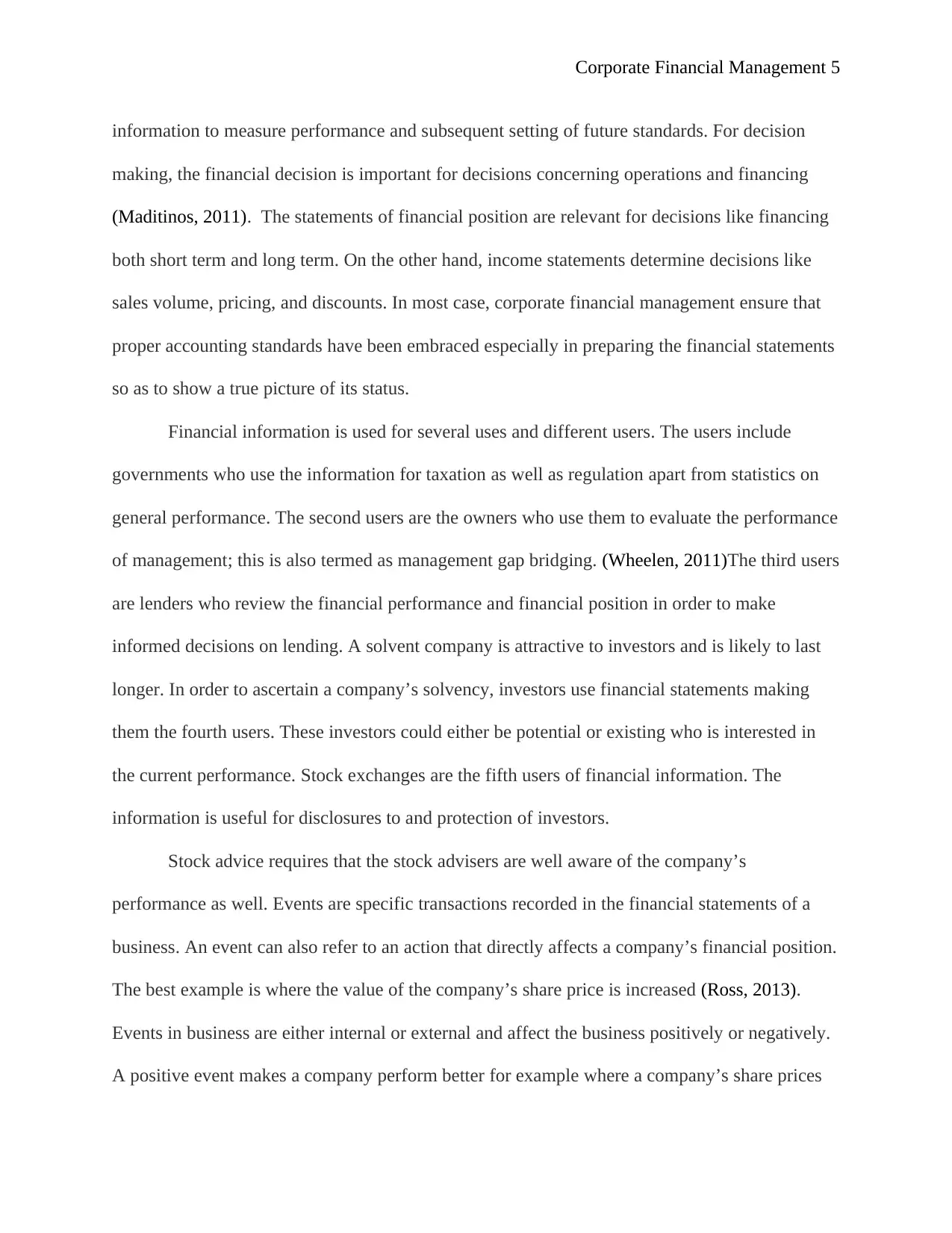
Corporate Financial Management 5
information to measure performance and subsequent setting of future standards. For decision
making, the financial decision is important for decisions concerning operations and financing
(Maditinos, 2011). The statements of financial position are relevant for decisions like financing
both short term and long term. On the other hand, income statements determine decisions like
sales volume, pricing, and discounts. In most case, corporate financial management ensure that
proper accounting standards have been embraced especially in preparing the financial statements
so as to show a true picture of its status.
Financial information is used for several uses and different users. The users include
governments who use the information for taxation as well as regulation apart from statistics on
general performance. The second users are the owners who use them to evaluate the performance
of management; this is also termed as management gap bridging. (Wheelen, 2011)The third users
are lenders who review the financial performance and financial position in order to make
informed decisions on lending. A solvent company is attractive to investors and is likely to last
longer. In order to ascertain a company’s solvency, investors use financial statements making
them the fourth users. These investors could either be potential or existing who is interested in
the current performance. Stock exchanges are the fifth users of financial information. The
information is useful for disclosures to and protection of investors.
Stock advice requires that the stock advisers are well aware of the company’s
performance as well. Events are specific transactions recorded in the financial statements of a
business. An event can also refer to an action that directly affects a company’s financial position.
The best example is where the value of the company’s share price is increased (Ross, 2013).
Events in business are either internal or external and affect the business positively or negatively.
A positive event makes a company perform better for example where a company’s share prices
information to measure performance and subsequent setting of future standards. For decision
making, the financial decision is important for decisions concerning operations and financing
(Maditinos, 2011). The statements of financial position are relevant for decisions like financing
both short term and long term. On the other hand, income statements determine decisions like
sales volume, pricing, and discounts. In most case, corporate financial management ensure that
proper accounting standards have been embraced especially in preparing the financial statements
so as to show a true picture of its status.
Financial information is used for several uses and different users. The users include
governments who use the information for taxation as well as regulation apart from statistics on
general performance. The second users are the owners who use them to evaluate the performance
of management; this is also termed as management gap bridging. (Wheelen, 2011)The third users
are lenders who review the financial performance and financial position in order to make
informed decisions on lending. A solvent company is attractive to investors and is likely to last
longer. In order to ascertain a company’s solvency, investors use financial statements making
them the fourth users. These investors could either be potential or existing who is interested in
the current performance. Stock exchanges are the fifth users of financial information. The
information is useful for disclosures to and protection of investors.
Stock advice requires that the stock advisers are well aware of the company’s
performance as well. Events are specific transactions recorded in the financial statements of a
business. An event can also refer to an action that directly affects a company’s financial position.
The best example is where the value of the company’s share price is increased (Ross, 2013).
Events in business are either internal or external and affect the business positively or negatively.
A positive event makes a company perform better for example where a company’s share prices
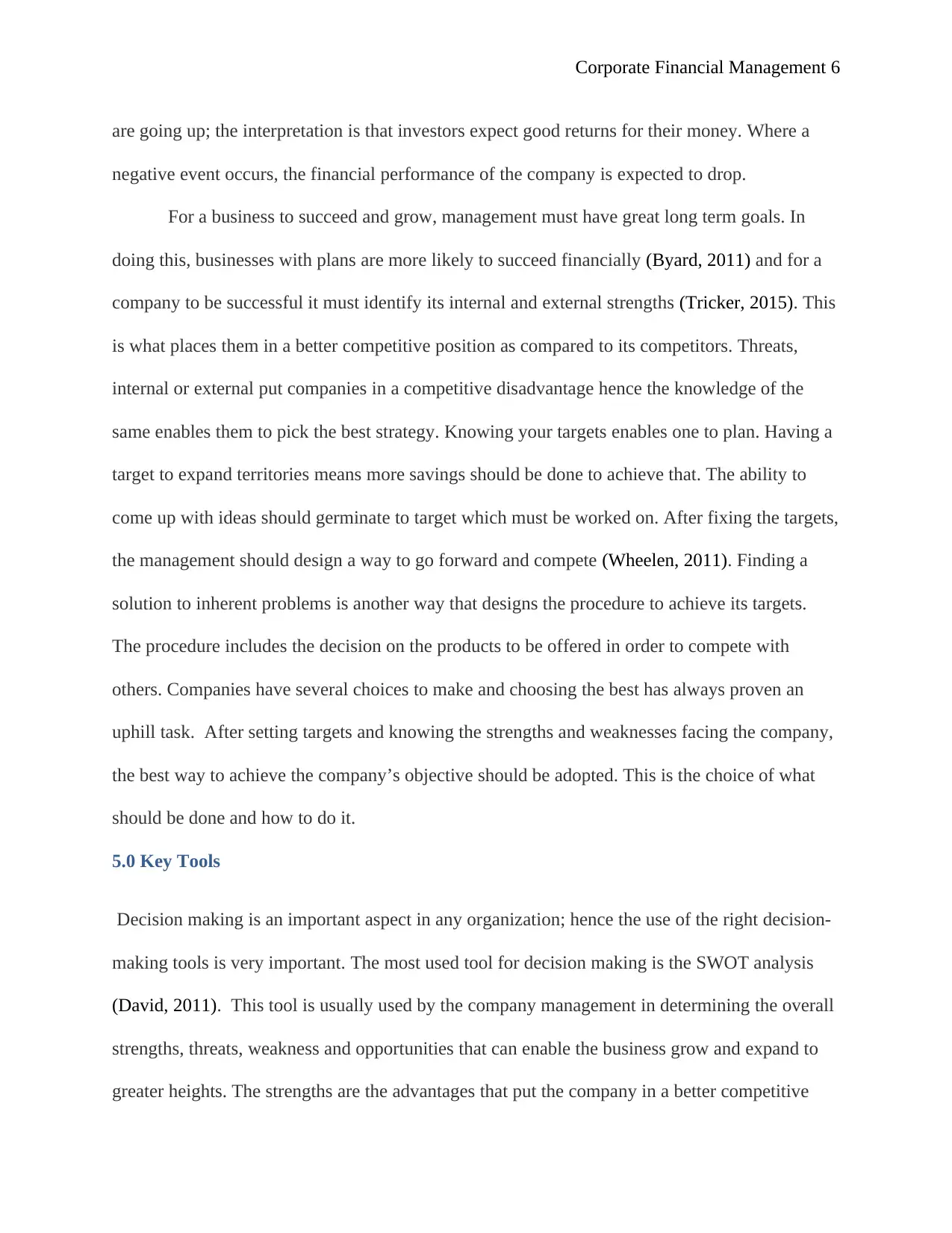
Corporate Financial Management 6
are going up; the interpretation is that investors expect good returns for their money. Where a
negative event occurs, the financial performance of the company is expected to drop.
For a business to succeed and grow, management must have great long term goals. In
doing this, businesses with plans are more likely to succeed financially (Byard, 2011) and for a
company to be successful it must identify its internal and external strengths (Tricker, 2015). This
is what places them in a better competitive position as compared to its competitors. Threats,
internal or external put companies in a competitive disadvantage hence the knowledge of the
same enables them to pick the best strategy. Knowing your targets enables one to plan. Having a
target to expand territories means more savings should be done to achieve that. The ability to
come up with ideas should germinate to target which must be worked on. After fixing the targets,
the management should design a way to go forward and compete (Wheelen, 2011). Finding a
solution to inherent problems is another way that designs the procedure to achieve its targets.
The procedure includes the decision on the products to be offered in order to compete with
others. Companies have several choices to make and choosing the best has always proven an
uphill task. After setting targets and knowing the strengths and weaknesses facing the company,
the best way to achieve the company’s objective should be adopted. This is the choice of what
should be done and how to do it.
5.0 Key Tools
Decision making is an important aspect in any organization; hence the use of the right decision-
making tools is very important. The most used tool for decision making is the SWOT analysis
(David, 2011). This tool is usually used by the company management in determining the overall
strengths, threats, weakness and opportunities that can enable the business grow and expand to
greater heights. The strengths are the advantages that put the company in a better competitive
are going up; the interpretation is that investors expect good returns for their money. Where a
negative event occurs, the financial performance of the company is expected to drop.
For a business to succeed and grow, management must have great long term goals. In
doing this, businesses with plans are more likely to succeed financially (Byard, 2011) and for a
company to be successful it must identify its internal and external strengths (Tricker, 2015). This
is what places them in a better competitive position as compared to its competitors. Threats,
internal or external put companies in a competitive disadvantage hence the knowledge of the
same enables them to pick the best strategy. Knowing your targets enables one to plan. Having a
target to expand territories means more savings should be done to achieve that. The ability to
come up with ideas should germinate to target which must be worked on. After fixing the targets,
the management should design a way to go forward and compete (Wheelen, 2011). Finding a
solution to inherent problems is another way that designs the procedure to achieve its targets.
The procedure includes the decision on the products to be offered in order to compete with
others. Companies have several choices to make and choosing the best has always proven an
uphill task. After setting targets and knowing the strengths and weaknesses facing the company,
the best way to achieve the company’s objective should be adopted. This is the choice of what
should be done and how to do it.
5.0 Key Tools
Decision making is an important aspect in any organization; hence the use of the right decision-
making tools is very important. The most used tool for decision making is the SWOT analysis
(David, 2011). This tool is usually used by the company management in determining the overall
strengths, threats, weakness and opportunities that can enable the business grow and expand to
greater heights. The strengths are the advantages that put the company in a better competitive
⊘ This is a preview!⊘
Do you want full access?
Subscribe today to unlock all pages.

Trusted by 1+ million students worldwide
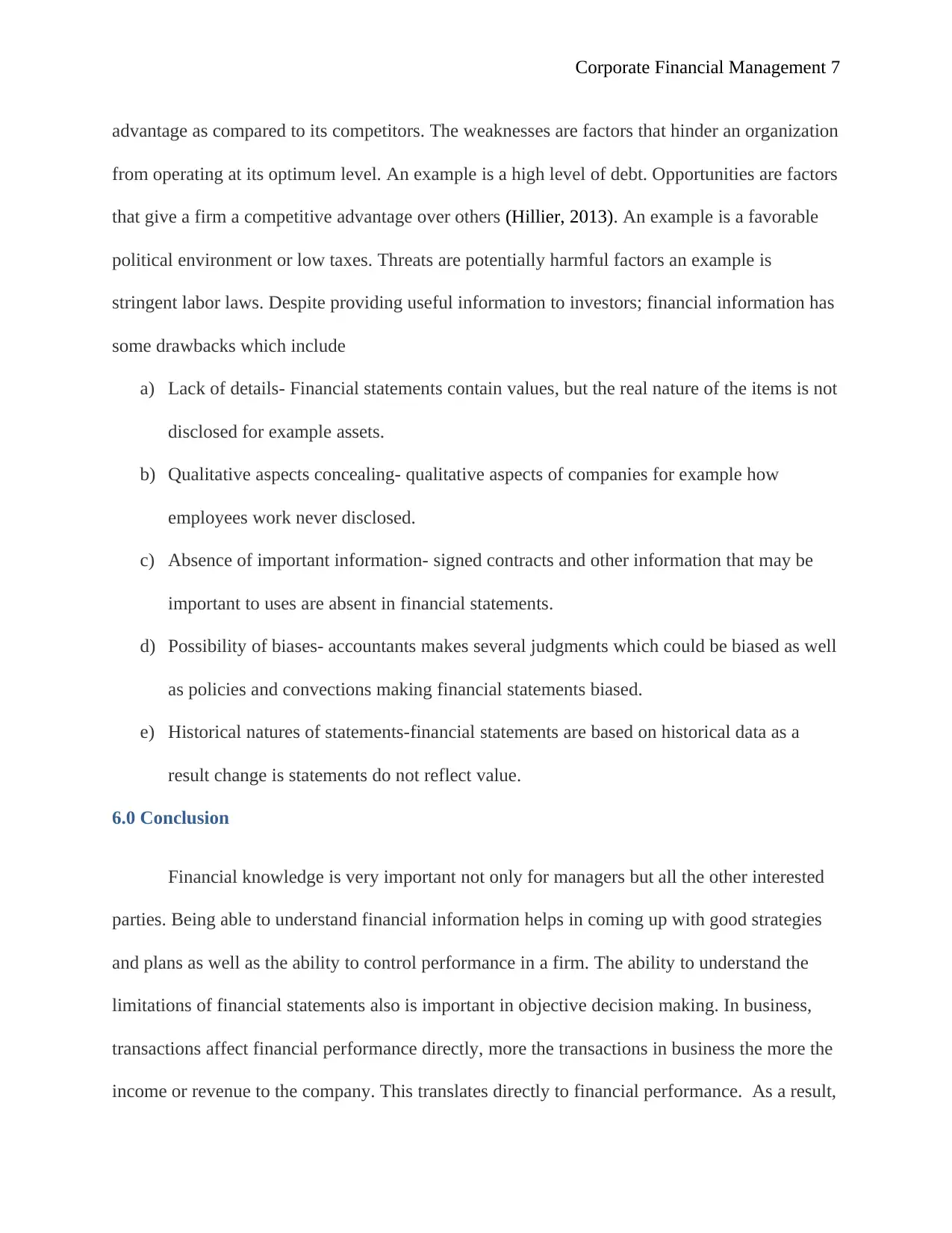
Corporate Financial Management 7
advantage as compared to its competitors. The weaknesses are factors that hinder an organization
from operating at its optimum level. An example is a high level of debt. Opportunities are factors
that give a firm a competitive advantage over others (Hillier, 2013). An example is a favorable
political environment or low taxes. Threats are potentially harmful factors an example is
stringent labor laws. Despite providing useful information to investors; financial information has
some drawbacks which include
a) Lack of details- Financial statements contain values, but the real nature of the items is not
disclosed for example assets.
b) Qualitative aspects concealing- qualitative aspects of companies for example how
employees work never disclosed.
c) Absence of important information- signed contracts and other information that may be
important to uses are absent in financial statements.
d) Possibility of biases- accountants makes several judgments which could be biased as well
as policies and convections making financial statements biased.
e) Historical natures of statements-financial statements are based on historical data as a
result change is statements do not reflect value.
6.0 Conclusion
Financial knowledge is very important not only for managers but all the other interested
parties. Being able to understand financial information helps in coming up with good strategies
and plans as well as the ability to control performance in a firm. The ability to understand the
limitations of financial statements also is important in objective decision making. In business,
transactions affect financial performance directly, more the transactions in business the more the
income or revenue to the company. This translates directly to financial performance. As a result,
advantage as compared to its competitors. The weaknesses are factors that hinder an organization
from operating at its optimum level. An example is a high level of debt. Opportunities are factors
that give a firm a competitive advantage over others (Hillier, 2013). An example is a favorable
political environment or low taxes. Threats are potentially harmful factors an example is
stringent labor laws. Despite providing useful information to investors; financial information has
some drawbacks which include
a) Lack of details- Financial statements contain values, but the real nature of the items is not
disclosed for example assets.
b) Qualitative aspects concealing- qualitative aspects of companies for example how
employees work never disclosed.
c) Absence of important information- signed contracts and other information that may be
important to uses are absent in financial statements.
d) Possibility of biases- accountants makes several judgments which could be biased as well
as policies and convections making financial statements biased.
e) Historical natures of statements-financial statements are based on historical data as a
result change is statements do not reflect value.
6.0 Conclusion
Financial knowledge is very important not only for managers but all the other interested
parties. Being able to understand financial information helps in coming up with good strategies
and plans as well as the ability to control performance in a firm. The ability to understand the
limitations of financial statements also is important in objective decision making. In business,
transactions affect financial performance directly, more the transactions in business the more the
income or revenue to the company. This translates directly to financial performance. As a result,
Paraphrase This Document
Need a fresh take? Get an instant paraphrase of this document with our AI Paraphraser

Corporate Financial Management 8
companies strive to transact more in order to perform better (Chandra, 2011). Technological
advancements have made it possible for firms to transact more and as a result, firms have
performed much better in the wake of mobile technology which in most case enhances the
overall growth and expansion.
companies strive to transact more in order to perform better (Chandra, 2011). Technological
advancements have made it possible for firms to transact more and as a result, firms have
performed much better in the wake of mobile technology which in most case enhances the
overall growth and expansion.
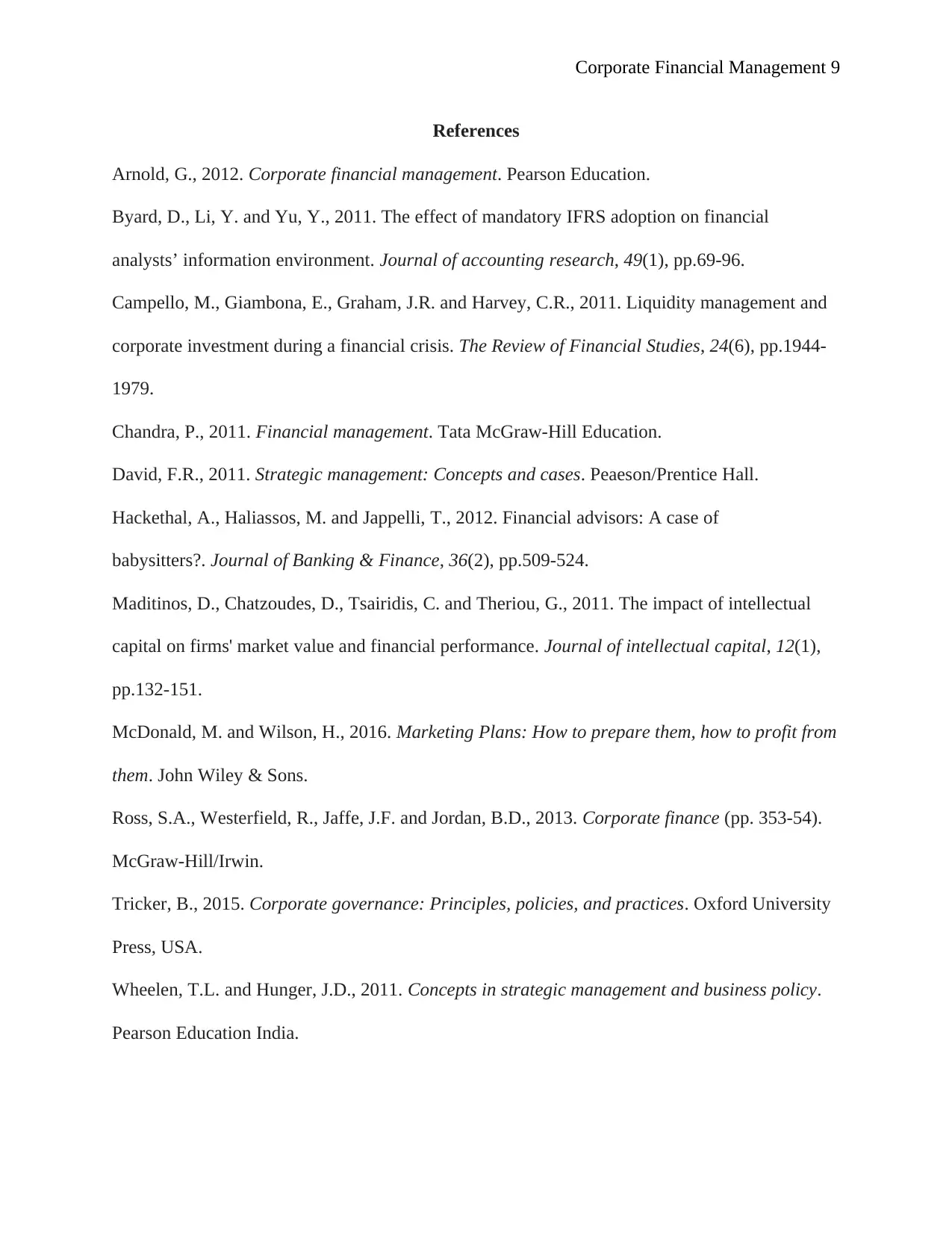
Corporate Financial Management 9
References
Arnold, G., 2012. Corporate financial management. Pearson Education.
Byard, D., Li, Y. and Yu, Y., 2011. The effect of mandatory IFRS adoption on financial
analysts’ information environment. Journal of accounting research, 49(1), pp.69-96.
Campello, M., Giambona, E., Graham, J.R. and Harvey, C.R., 2011. Liquidity management and
corporate investment during a financial crisis. The Review of Financial Studies, 24(6), pp.1944-
1979.
Chandra, P., 2011. Financial management. Tata McGraw-Hill Education.
David, F.R., 2011. Strategic management: Concepts and cases. Peaeson/Prentice Hall.
Hackethal, A., Haliassos, M. and Jappelli, T., 2012. Financial advisors: A case of
babysitters?. Journal of Banking & Finance, 36(2), pp.509-524.
Maditinos, D., Chatzoudes, D., Tsairidis, C. and Theriou, G., 2011. The impact of intellectual
capital on firms' market value and financial performance. Journal of intellectual capital, 12(1),
pp.132-151.
McDonald, M. and Wilson, H., 2016. Marketing Plans: How to prepare them, how to profit from
them. John Wiley & Sons.
Ross, S.A., Westerfield, R., Jaffe, J.F. and Jordan, B.D., 2013. Corporate finance (pp. 353-54).
McGraw-Hill/Irwin.
Tricker, B., 2015. Corporate governance: Principles, policies, and practices. Oxford University
Press, USA.
Wheelen, T.L. and Hunger, J.D., 2011. Concepts in strategic management and business policy.
Pearson Education India.
References
Arnold, G., 2012. Corporate financial management. Pearson Education.
Byard, D., Li, Y. and Yu, Y., 2011. The effect of mandatory IFRS adoption on financial
analysts’ information environment. Journal of accounting research, 49(1), pp.69-96.
Campello, M., Giambona, E., Graham, J.R. and Harvey, C.R., 2011. Liquidity management and
corporate investment during a financial crisis. The Review of Financial Studies, 24(6), pp.1944-
1979.
Chandra, P., 2011. Financial management. Tata McGraw-Hill Education.
David, F.R., 2011. Strategic management: Concepts and cases. Peaeson/Prentice Hall.
Hackethal, A., Haliassos, M. and Jappelli, T., 2012. Financial advisors: A case of
babysitters?. Journal of Banking & Finance, 36(2), pp.509-524.
Maditinos, D., Chatzoudes, D., Tsairidis, C. and Theriou, G., 2011. The impact of intellectual
capital on firms' market value and financial performance. Journal of intellectual capital, 12(1),
pp.132-151.
McDonald, M. and Wilson, H., 2016. Marketing Plans: How to prepare them, how to profit from
them. John Wiley & Sons.
Ross, S.A., Westerfield, R., Jaffe, J.F. and Jordan, B.D., 2013. Corporate finance (pp. 353-54).
McGraw-Hill/Irwin.
Tricker, B., 2015. Corporate governance: Principles, policies, and practices. Oxford University
Press, USA.
Wheelen, T.L. and Hunger, J.D., 2011. Concepts in strategic management and business policy.
Pearson Education India.
⊘ This is a preview!⊘
Do you want full access?
Subscribe today to unlock all pages.

Trusted by 1+ million students worldwide
1 out of 9